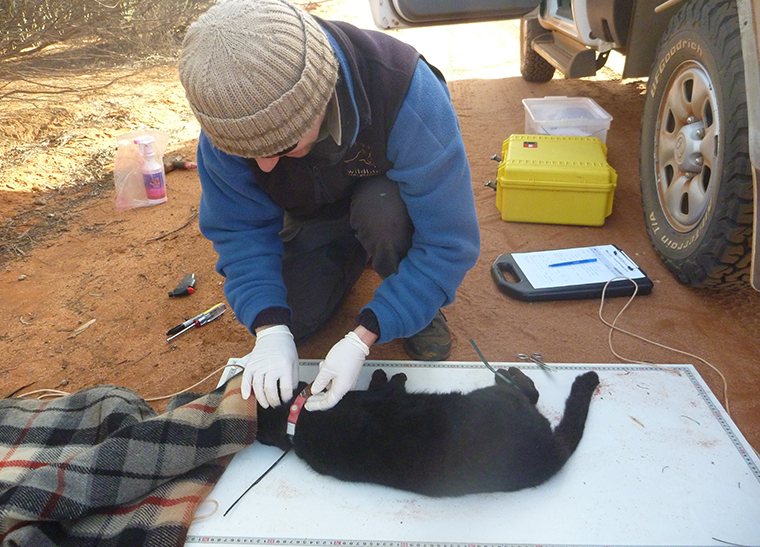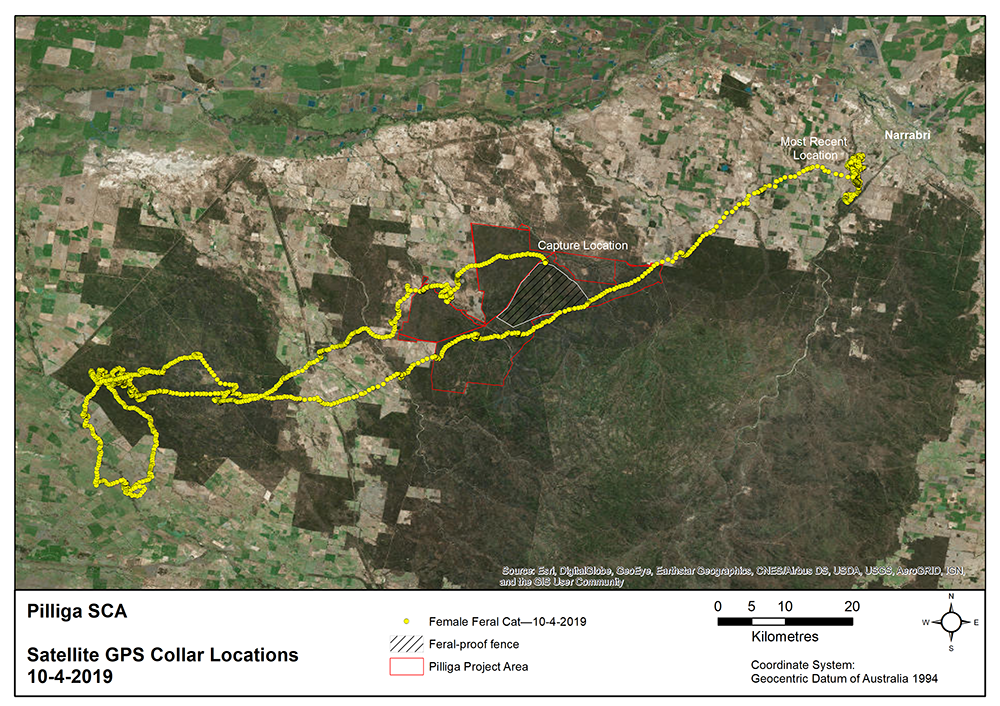By Dr Andrew Carter, Wildlife Ecologist, and Dr David Roshier, Regional Senior Ecologist (Research)
Since 2015, AWC ecologists at Scotia Wildlife Sanctuary have been undertaking one of the most important research projects in Australia on the ecology of feral cats and foxes ‘beyond the fence’. Now this research is being extended to the Pilliga and Mt Gibson Wildlife Sanctuary.
For three years the AWC team at Scotia has been undertaking this research in a bid to help us manage foxes and feral cats more effectively in open (unfenced) landscapes. These predators kill more than 2,000 animals every minute in Australia.
 © AWC
© AWC
While there is no existing strategy or technology that can provide an effective control nationwide, fenced predator-free areas, like at Scotia Wildlife Sanctuary, offer an immediate and permanent refuge for threatened wildlife. AWC manages the largest cat and fox-free areas on mainland Australia, but even at the scale built by AWC, these fenced safe-havens still only cover a small proportion of Australia’s landscape.
AWC’s research project incorporates four linked phases, with the ultimate goal being to identify whether the density of cats and foxes can be suppressed (in the absence of a fence) to levels that are low enough to permit native mammals to increase, or in the case of regionally extinct species, to allow them to re- establish self-sustaining populations.
Phase 1: Developing reliable estimates of the density of foxes and feral cats
Since October 2015, AWC has fitted 28 foxes and 30 cats with GPS collars outside the conservation fence at Scotia. These collars have collectively yielded more than 200,000 location data points. The telemetry data have enabled estimation of home-range size, encounter rates with cameras, and individual identity of photographed animals. When combined with analysis of images from monthly camera-trap surveys, these data have facilitated robust estimates of population density of foxes at Scotia (on average, eight foxes per 10,000 hectares). AWC’s efforts are now focused on estimating the density of feral cats, although this is more challenging as cats have been more nomadic at Scotia than foxes during the period of the research project.
 © AWC
© AWC
Phase 2: Examining the response of foxes and feral cats to fox control
In October 2017, fox control was implemented in the experimental study area at Scotia for the first time in more than five years. Nine foxes fitted with GPS collars were present in the study area when fox baiting commenced, and within one month, eight of those nine foxes were dead. As baiting removed all except one of the collared foxes, estimates of fox density, for this period, will need a different methodology that does not require individual foxes to be identified in photographs. Work is continuing on developing this method, with results likely to be available in the second half of 2019.
Phase 3: Examining the response of foxes and feral cats to integrated fox and cat control
Implementation of this phase of the project will be dependent on AWC obtaining regulatory approval for deployment of cat baits in NSW.
Phase 4: Reintroducing threatened mammals ‘beyond the fence’
Progressing to this phase will be dependent on our ability to maintain fox and cat populations at low densities for an extended period of time, hence the importance of having an effective means of feral predator control (for cats, these methods are still in development) and having reliable methods for estimating the population density of feral predators (the current focus of AWC’s research at Scotia).
Expanding the research
The research at Scotia is now expanding in scope to include fieldwork on two other sites – at the Pilliga project site in New South Wales, and at AWC’s Mt Gibson Wildlife Sanctuary in Western Australia.
The research at the Pilliga involves the deployment of an array of camera traps across 15,000 hectares. Feral cats and foxes will be caught in this area during winter 2019 and fitted with GPS collars to track their movements and monitor the effectiveness of predator control activities. One cat, trapped in late 2018, has already travelled more than 170 kilometres across the region. This research will provide crucial insights into how the findings from Scotia relate to other environments. Importantly, it will help to refine the methodology for calculating population density estimates of feral cats and foxes – something that, until now, has not been possible to achieve in Australia.
Ultimately, this research will enable AWC and others to measure and improve the effectiveness of feral predator control at a landscape scale for the benefit of Australia’s native wildlife.
At Mt Gibson Wildlife Sanctuary, cameras will be deployed across 12,000 hectares to monitor changes in predator densities in response to control measures, with the aim of facilitating the reintroduction of the Western Quoll and Brushtail Possum.
Please support AWC’s ground-breaking research for controlling feral predators ‘beyond the fence.’
$150 will purchase a cage trap for catching feral cats and foxes
$500 will fund a scientist delivering research in the field for one day
$4,000 will help purchase a GPS collar for essential scientific research